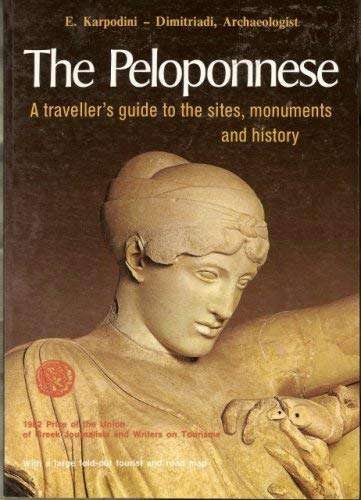
The Peloponnese: A Traveller's Guide to the Sites, Monuments and History
Check my rate
| Main centres: | 1-3 business days |
| Regional areas: | 3-4 business days |
| Remote areas: | 3-5 business days |

| Main centres: | 1-3 business days |
| Regional areas: | 3-4 business days |
| Remote areas: | 3-5 business days |
Published by E P Dutton, 1983, softcover, 208 pages, illustrated, fold-out map, condition: very good.
"The Peloponnese," by archaeologist E. Karpodini-Dimitriadi was the volume that our tour guide, Poupi, recommended for the first two days of our tour of Greece. This was when traveled from Athens down to the Peloponnese, crossing the Corinth canal on our way to visiting Old Corinth, Mycenea, Epidaurus, Nauplion, and Olympia. The book is actually organized pretty much along similar lines, starting in the northeast corner and working around the Peloponnese in a general circle, clockwise. Consequently, as you look over any given section there is a good chance that the next one is a place that you are heading towards.
If you are traveling around Greece by bus this is ideal, because you are talking about a half-dozen pages on a particular location, which you can readily read on the bus. There is an introductory section on the general history of the Peloponnese, which is basically a history of Greece as well. For each particular location there is an initial description of the geographic location, a history of the region, and descriptions of the sites. If there is a local museum that is given its own subsection detailing the key treasures you can see there. The goal is clearly to provide a better appreciation for these sites rather than to substitute for the experience of visiting them. You can also use this information to decide what it is you want to see: if you check out Ancient Corinth then you can decide if you want to go up and check out Acrocorinth. There are flaps on both the front and back cover that you can use as bookmarks to mark places. Taking the book with you as you tour the sites is not rally going to work, especially if you are also carting around a camera. But reading it before and after your visit is really not a big effort.
Copies of "The Peloponnese" are literally available all over the southern part of Greece, at every ancient site, hotel, and most stores. Additionally, the book is available in most major languages, again solidifying its reputation as a tourist friendly volume. No wonder it won the 1982 Prize of the Union of Greek Journalists and Writers on Tourism. Of course, this becomes the only serious complaint with the book, that it was written in 1981 (and there is no indication that it has been updated). This is a richly illustrated volume, with color photographs of the site, along with pictures of key artifacts discovered at each (even if they are in museums in Athens), and maps of the archaeological ruins you will be visiting. There are also some reconstructions of ancient locations, to give you an idea of what a place like Olympia looked like in its glory days. Like all traveler's guides you will find in Greece, "The Peloponnese" is affordably priced (amazingly so). You can pick up volumes on key individual locations (e.g., Mycenae, Olympia), but "The Peloponnese" is the best single volume for sites, monuments and history in this part of Greece.